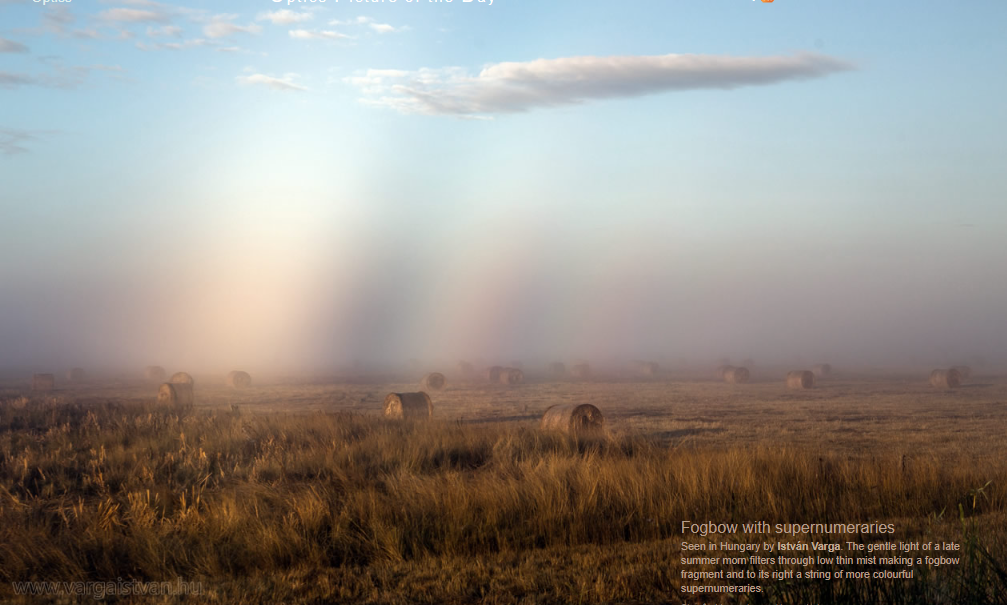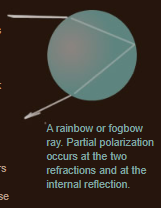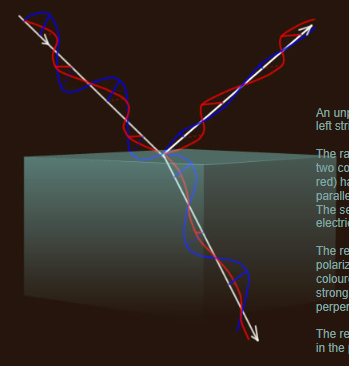Fogbow & Polarization - OPOD
Fogbow & Polarization: A Phenomenon of Light
When it comes to atmospheric optics, fogbows and rainbows have always captured our imagination with their ethereal beauty. But have you ever wondered about the role of polarization in these captivating phenomena? In this article, we will delve deeper into the fascinating connection between fogbows, rainbows, and polarization.
Unveiling the Mystery of Polarization
To understand the interplay between fogbows, rainbows, and polarization, let's first explore the concept of polarization itself. When light encounters water, it undergoes reflection and refraction, resulting in partial polarization. The electric vector of light waves parallel to the water's surface is more strongly reflected, while those perpendicular to it are refracted.
At a specific angle known as the Brewster angle, the rays become completely polarized. This phenomenon occurs because the parallel component of the electric vector is stronger in the reflected ray, while the perpendicular component dominates in the refracted ray. Both fogbows and rainbows undergo two refractions and an internal reflection, leading to their polarization.
The Intriguing Effects of Polarizing Filters
Now, let's introduce polarizing filters into the equation. These filters have peculiar effects on both fogbows and their close relatives, rainbows. When a polarizing filter is used, certain areas of the fogbow remain bright with enhanced contrast against the sky, while other parts seem to almost disappear. By rotating the filter, you can observe how the bright and dark areas move along the curve of the bow.
Rainbows are strongly polarized, whereas fogbows exhibit less polarization but still enough to display noticeable effects. The polarization directions of both these optical phenomena are radial and tangential to the curve of the bow.
Supernumeraries: A Mesmerizing Addition
Supernumeraries, those additional colorful bands sometimes visible within a fogbow or rainbow, add an extra touch of magic to the scene. Interestingly, when a polarizer is rotated, the distance between the supernumeraries and the main bow shifts. In certain positions, the supernumeraries become more pronounced and vivid.
The changing position of the supernumeraries arises from the interference between two rays with the same deflection angle. When the polarizer's electric vector aligns tangentially with the bow, the supernumeraries occupy the spots that are usually occupied by the dark gaps between the fringes observed when the filter is rotated 90 degrees. The visibility of these fringes weakens without a polarizing filter, as the superimposition of the two sets of fringes reduces their prominence.
Capturing the Beauty of Fogbows and Supernumeraries
If you wish to witness strong supernumeraries within a fogbow, using a polarizer can enhance their visibility. However, it is worth noting that this technique will only work on a small fragment of the fogbow, as demonstrated in the image above. Nevertheless, this fragment showcases the mesmerizing interplay between polarization and atmospheric optics.
Conclusion: A Kaleidoscope of Light
In conclusion, fogbows and rainbows are not only captivating displays of nature's beauty but also provide valuable insights into the behavior of light waves and polarization. The polarization of light as it interacts with water plays a crucial role in shaping these optical phenomena. By employing polarizing filters, we can uncover hidden details and observe the shifting positions of supernumeraries within fogbows.
Next time you encounter a fogbow or a rainbow, take a moment to appreciate the intricate dance between light, water, and polarization. These enchanting displays serve as reminders of the wonders that lie within our atmosphere and the endless mysteries waiting to be unveiled.

Fogbow with supernumeraries
Seen in Hungary by István Varga. The gentle light of a late summer morn filters through low thin mist making a fogbow fragment and to its right a string of more colourful supernumeraries.
©Istv�n Varga, shown with permission

Polarization & Fogbows
Istv�n used a polarizing filter. They do odd things to a fogbow and its close cousin the rainbow.
Part of the bow stays bright with enhanced contrast against the sky. Other parts almost disappear. Rotate the filter and the bright and dark areas move around the curve of the bow. Rainbows are strongly polarized, fogbows are less so but still enough to show effects.
Why?
When unpolarized light strikes water, part is reflected and a part enters the liquid. Both rays are partially polarized. Waves with their electric vector parallel to the surface are more strongly reflected. Waves whose electric vector is perpendicular are more strongly refracted. Thus both reflected and refracted rays are polarized to some extent. At one particular angle, the Brewster angle, the rays are completely polarized.
Fogbow and rainbow light undergoes two refractions and an internal reflection and becomes polarized. The polarization directions are radial and tangential to the bow’s curve.
Supernumeraries show extra effects
Supernumeraries shift in distance from the main bow as a polarizer is rotated. In some positions they are nicely enhanced.
When the polarizer's electric vector is tangent to the bow the supernumeraries occupy the position of the dark gaps between the fringes seen when the filter is rotated 90°. The changing position arises because supernumeraries are produced by interference between two rays having the same deflection angle. The superimposition of these two sets of fringes weakens their visibility without a polarizing filter.
For strong supernumeraries use a polarizer.. ..but that will only work on a small fragment as above.

An unpolarized ray from the left strikes a water surface.
The ray can be thought of as two components. One (in red) has its electric vector parallel to the water surface. The second (in blue) has its electric vector at right angles.
The reflected ray is partially polarized. The parallel (red coloured) component is stronger than that with perpendicular polarization.
The refracted ray is weaker in the parallel component.
Note: this article has been automatically converted from the old site and may not appear as intended. You can find the original article here.
Reference Atmospheric Optics
If you use any of the definitions, information, or data presented on Atmospheric Optics, please copy the link or reference below to properly credit us as the reference source. Thank you!
-
<a href="https://atoptics.co.uk/blog/fogbow-polarization-opod/">Fogbow & Polarization - OPOD</a>
-
"Fogbow & Polarization - OPOD". Atmospheric Optics. Accessed on November 22, 2024. https://atoptics.co.uk/blog/fogbow-polarization-opod/.
-
"Fogbow & Polarization - OPOD". Atmospheric Optics, https://atoptics.co.uk/blog/fogbow-polarization-opod/. Accessed 22 November, 2024
-
Fogbow & Polarization - OPOD. Atmospheric Optics. Retrieved from https://atoptics.co.uk/blog/fogbow-polarization-opod/.